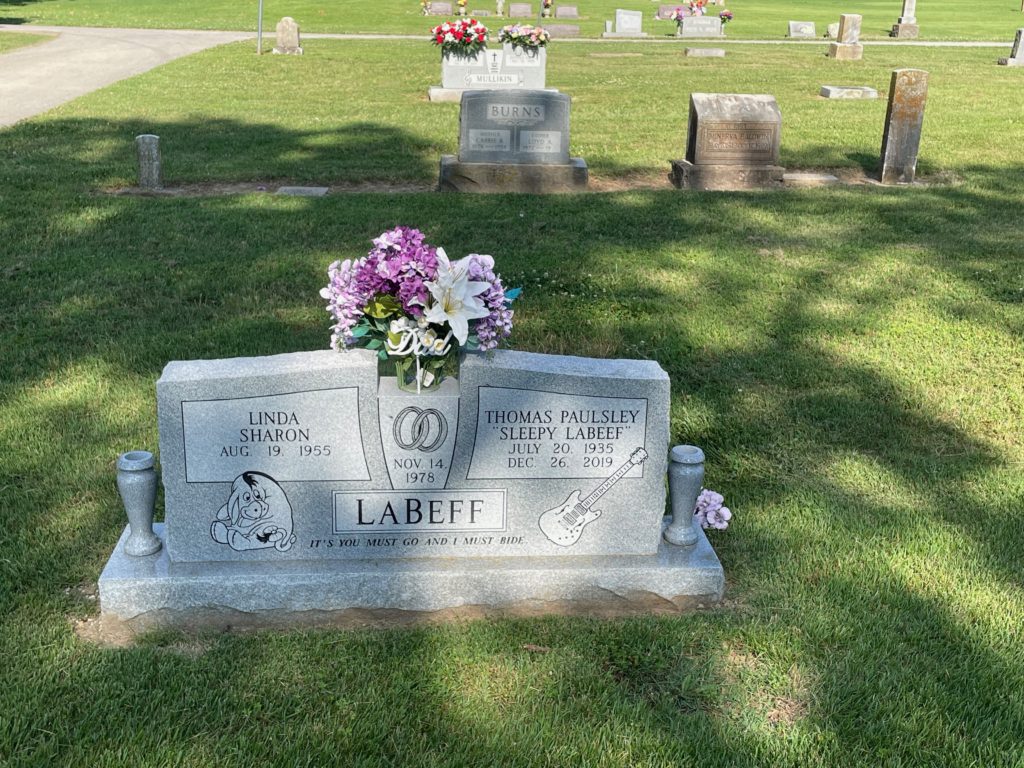Erik Visits an American Grave, Part 935
This is the grave of Sleepy LaBeef.

Born in 1935 in the ridiculously named Smackover, Arkansas, Thomas LaBeff grew up on a farm growing cotton and watermelons. His nickname Sleepy came from his lazy eye. On the other hand, he became very tall for the time. He was 6’6″, a near giant for the era. So he had a unique look. He became a lot more interested in music and farming. Like kids throughout the South, he had access to a big range of music. He was a huge country music fan and also heard a lot of the Black music in the era that whites tried to keep away from their children. He learned the guitar and decided to try his hand as a musician, moving to Houston to do so in 1953. That was where George Jones got noticed and the Possum was one of LaBeff’s big influences, along with Bill Monroe and Sister Rosetta Tharpe. He had some limited success there. He played in bar bands and got gigs on the Louisiana Hayride and other radio shows. This hardly made him a guarantee on the road to success, but he was now a someone.
By the mid 1950s, popular music was undergoing a rapid revolution that would usher in the age of rock and roll. But we should not forget the transitional music that everyone knows but few really listen to, which is rockabilly. LaBeef began shifting from his country sound to one more based in rock and roll and became one of the key figures in that short lived genre of rock. In 1957, signed to Starday Records, which was also George Jones’ label, he released “I’m Through” under his stage name of Sleepy LaBeef. Through the late 50s and into the early 60s, he continued to mine this kind of material, though switching labels frequently because he wasn’t having much success.
Like a lot of rockabilly and early white rock artists, by the mid 60s, LaBeef had returned to country music. This was Jerry Lee Lewis’ path too once his musical style and personal life got in the way of his success. Like the Killer, LaBeef was a pretty good country singer and had some minor success in it. He finally hit the charts for the first time in 1968, when “Every Day” topped out at #73 on the country charts. Not much, but it was something. In 1971, he went to #67 with “Blackland Farmer.” He also, due to his large size, became someone that horror movie directors might cast and in fact he played the Swamp Thing in Ron Ormond’s 1968 cult classic The Exotic Ones.
In terms of sustained record sales, LaBeef never had much success. The early 1970s were not very good for his kind of tunes. But by the 1980s, he gained a cult following in Europe and toured significantly over there. That helped lead to a revival of sorts for him in the U.S. too. LaBeef was a lifer. He was just one of these musicians who could not imagine doing anything else, even if he was making no money at it. He often played around 300 shows a year, traveling around the U.S. and Europe. Even if the crowds were small and the money tight, he still couldn’t see himself doing anything else. He became something of a festival favorite later in life due to his energetic performances and fun rockabilly music that basically everyone likes to see every now and then unless you just have bad taste in music. LaBeef claimed to know 6,000 songs he could play live and I highly doubt he was exaggerating. That included rock and roll, hard country, gospel songs of both the Black and white traditions, blues, and a lot of other stuff too. In the 70s, he signed with Sun Records, though that was hardly the studio it had been 15 years later. In the 80s, he recorded for the folk label Rounder. By many accounts though, his live performances were vastly better than his fairly forgettable recordings.
LaBeef played almost to the end. His last show was in September 2019. But his heart was giving out. He died in December 2019. He was 84 years old.
Sleepy LaBeef is buried in Oak Hill Cemetery, Siloam Springs, Arkansas.
Let’s listen to some Sleepy LaBeef:
If you would like this series to visit other figures of the early rock and roll era, you can donate to cover the required expenses here. Chuck Berry is in St. Louis and Little Richard is in Huntsville, Alabama. Previous posts in this series are archived here.


